Java code analysis about program memory
This article mainly introduces relevant information on the analysis of program memory in Java. Friends who need it can refer to it.
This article will briefly explain the JVM (Java Virtual Machine) when we run a Java program. machine) memory allocation.
First of all, let’s get to know a few nouns perceptually:
1. Stack. Generally speaking, basic data types are directly in Space is allocated on the stack, and local variables (variables defined in the method code segment) are also directly allocated on the stack. When the method where the local variable is located is executed, the space is immediately reclaimed by the JVM. There is also a reference data type, namely What we usually call the reference corresponding to the object that needs to be created using the keyword new is also in the stack space. At this time, the JVM allocates an address space to the object reference in the stack space (equivalent to a house number, through this house number You can find your home by number), allocate a space in the heap space for the referenced object, and the address reference in the stack space points to the object area in the heap space (find the address through the house number);
2. Heap is generally used to store data generated using the new keyword.
Next, we will use a program to intuitively feel the memory situation of the JVM when the program is running.
package demo;
public class Student {
private String name;
private int age;
public void study() {
System.out.println("I love study!");
}
public String getName() {
return name;
}
public void setName(String name) {
this.name = name;
}
public int getAge() {
return age;
}
public void setAge(int age) {
this.age = age;
}
}package demo;
public class StudentDemo {
public static void main(String[] args) {
Student student = new Student();
System.out.println(student.getName() + ":" + student.getAge());
student.setName("John");
student.setAge(23);
System.out.println(student.getName() + ":" + student.getAge());
student.study();
Student student2 = student;
student2.setName("Jack");
student2.setAge(25);
System.out.println(student2.getName() + ":" + student2.getAge());
System.out.println(student.getName() + ":" + student.getAge());
}
}When we run the program, the JVM will compile the Student class and StudentDemo class and then load them Go to a place called the method area in the JVM. The member variables and member methods of the class are also loaded into the method area. At this time, the memory model is as follows
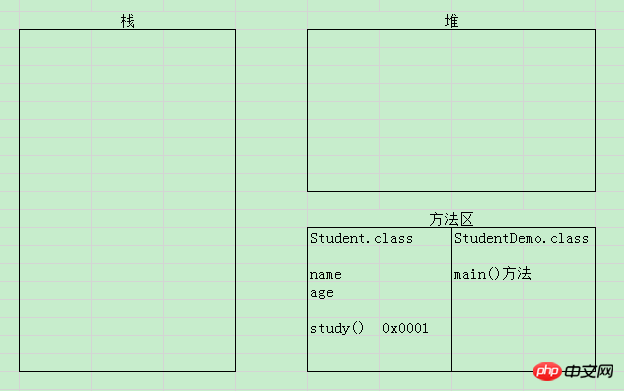
You can see the study method There is a hexadecimal mark on the right side, but the name and age variables do not. This is because each object has its own member variables, but the member methods in the class can be shared by each object. In order to save memory space, The JVM allocates this mark (also called a memory address) to the method so that each new object can be found and called. Then the JVM will automatically find the main method and apply for a space in the stack for the main method. This process is also called pushing onto the stack and then executing In the 5th line of code in our Student class, at this time, the JVM allocates a piece of memory to the Student object in the heap space and assigns it a memory address (if the object's member variables are not assigned a value, the JVM will assign an initial value to the variable). Allocate a memory space in the stack to point to the memory address of the Student object area in the heap space. At this time, the memory model is as follows
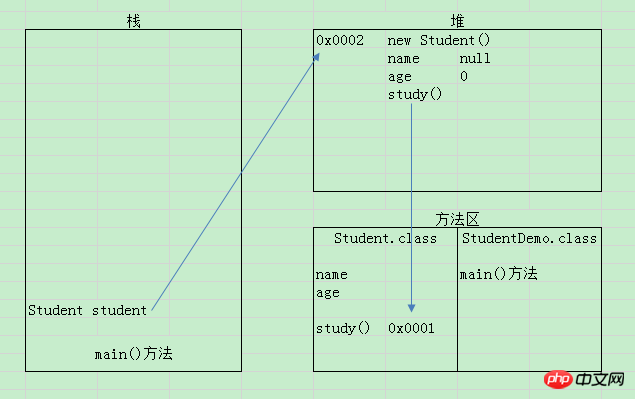
Then look at lines 8 and 9 of the code OK, the program assigns values to the member variables of the student object. The JVM will search for the variables of the Student class in the heap memory based on the address pointed by the student, and assign new values to the variables
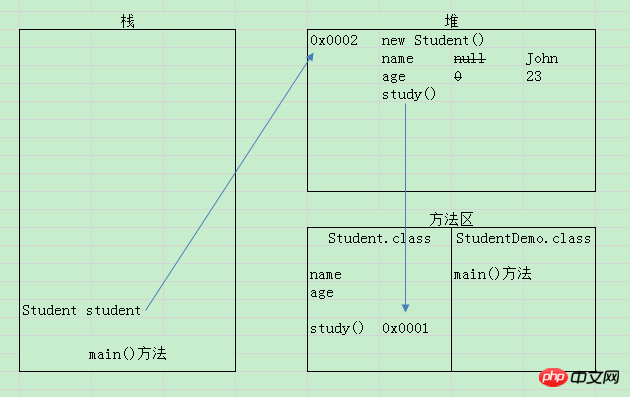
Line 12, at this time the student object calls the study method, and the JVM applies for a memory space in the stack space for the study method
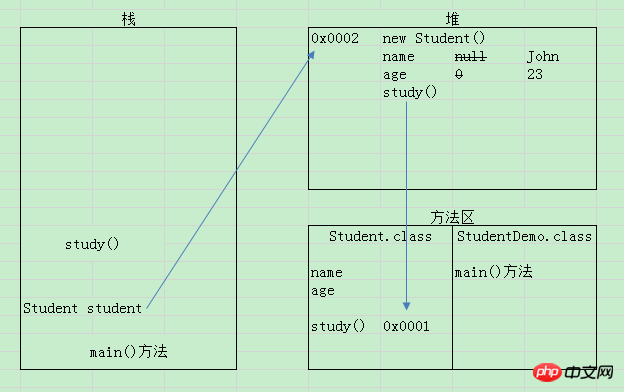
After the study method is executed, the stack is released immediately Space, code line 14, the reference of the student2 object points to the address pointed by student
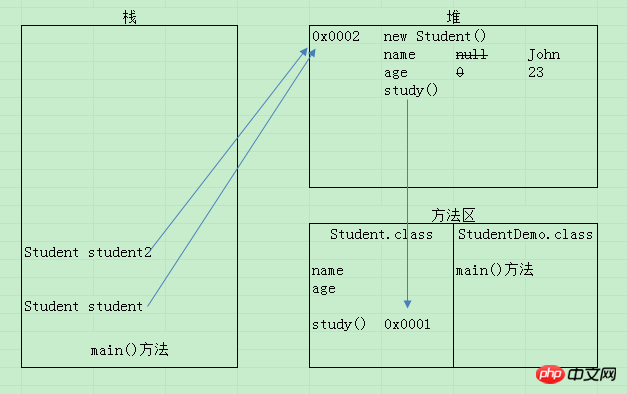
Code lines 15 and 16 assign values to the variables of student2, because student2 and student point to to the same place, so the value of the variable in the student object is also changed at this time
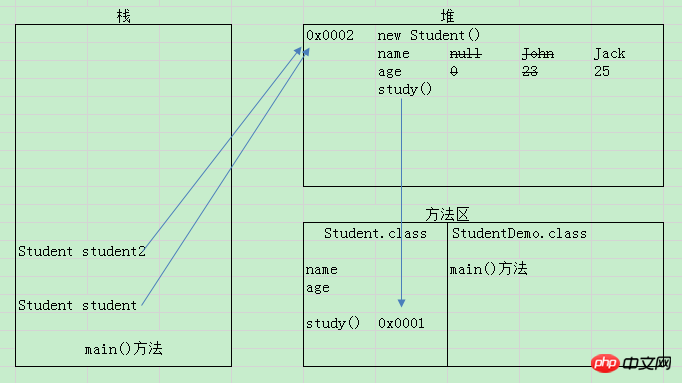
#At this point, all the code in the main method has been executed, and the stack space occupied by the main method Also recycled, while the heap space is waiting for GC recycling
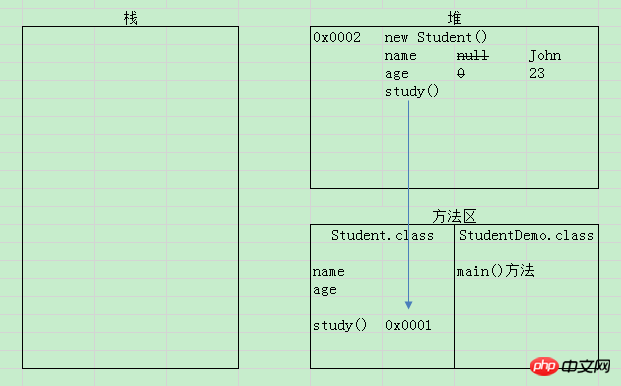
The code execution results are as follows:
null:0 John:23 I love study! Jack:25 Jack:25
The above is the detailed content of Java code analysis about program memory. For more information, please follow other related articles on the PHP Chinese website!

Hot AI Tools

Undresser.AI Undress
AI-powered app for creating realistic nude photos

AI Clothes Remover
Online AI tool for removing clothes from photos.

Undress AI Tool
Undress images for free

Clothoff.io
AI clothes remover

Video Face Swap
Swap faces in any video effortlessly with our completely free AI face swap tool!

Hot Article

Hot Tools

Notepad++7.3.1
Easy-to-use and free code editor

SublimeText3 Chinese version
Chinese version, very easy to use

Zend Studio 13.0.1
Powerful PHP integrated development environment

Dreamweaver CS6
Visual web development tools

SublimeText3 Mac version
God-level code editing software (SublimeText3)

Hot Topics
 Java Spring Interview Questions
Aug 30, 2024 pm 04:29 PM
Java Spring Interview Questions
Aug 30, 2024 pm 04:29 PM
In this article, we have kept the most asked Java Spring Interview Questions with their detailed answers. So that you can crack the interview.
 Break or return from Java 8 stream forEach?
Feb 07, 2025 pm 12:09 PM
Break or return from Java 8 stream forEach?
Feb 07, 2025 pm 12:09 PM
Java 8 introduces the Stream API, providing a powerful and expressive way to process data collections. However, a common question when using Stream is: How to break or return from a forEach operation? Traditional loops allow for early interruption or return, but Stream's forEach method does not directly support this method. This article will explain the reasons and explore alternative methods for implementing premature termination in Stream processing systems. Further reading: Java Stream API improvements Understand Stream forEach The forEach method is a terminal operation that performs one operation on each element in the Stream. Its design intention is
 PHP: A Key Language for Web Development
Apr 13, 2025 am 12:08 AM
PHP: A Key Language for Web Development
Apr 13, 2025 am 12:08 AM
PHP is a scripting language widely used on the server side, especially suitable for web development. 1.PHP can embed HTML, process HTTP requests and responses, and supports a variety of databases. 2.PHP is used to generate dynamic web content, process form data, access databases, etc., with strong community support and open source resources. 3. PHP is an interpreted language, and the execution process includes lexical analysis, grammatical analysis, compilation and execution. 4.PHP can be combined with MySQL for advanced applications such as user registration systems. 5. When debugging PHP, you can use functions such as error_reporting() and var_dump(). 6. Optimize PHP code to use caching mechanisms, optimize database queries and use built-in functions. 7
 PHP vs. Python: Understanding the Differences
Apr 11, 2025 am 12:15 AM
PHP vs. Python: Understanding the Differences
Apr 11, 2025 am 12:15 AM
PHP and Python each have their own advantages, and the choice should be based on project requirements. 1.PHP is suitable for web development, with simple syntax and high execution efficiency. 2. Python is suitable for data science and machine learning, with concise syntax and rich libraries.
 Java Program to Find the Volume of Capsule
Feb 07, 2025 am 11:37 AM
Java Program to Find the Volume of Capsule
Feb 07, 2025 am 11:37 AM
Capsules are three-dimensional geometric figures, composed of a cylinder and a hemisphere at both ends. The volume of the capsule can be calculated by adding the volume of the cylinder and the volume of the hemisphere at both ends. This tutorial will discuss how to calculate the volume of a given capsule in Java using different methods. Capsule volume formula The formula for capsule volume is as follows: Capsule volume = Cylindrical volume Volume Two hemisphere volume in, r: The radius of the hemisphere. h: The height of the cylinder (excluding the hemisphere). Example 1 enter Radius = 5 units Height = 10 units Output Volume = 1570.8 cubic units explain Calculate volume using formula: Volume = π × r2 × h (4
 PHP vs. Python: Core Features and Functionality
Apr 13, 2025 am 12:16 AM
PHP vs. Python: Core Features and Functionality
Apr 13, 2025 am 12:16 AM
PHP and Python each have their own advantages and are suitable for different scenarios. 1.PHP is suitable for web development and provides built-in web servers and rich function libraries. 2. Python is suitable for data science and machine learning, with concise syntax and a powerful standard library. When choosing, it should be decided based on project requirements.
 PHP vs. Other Languages: A Comparison
Apr 13, 2025 am 12:19 AM
PHP vs. Other Languages: A Comparison
Apr 13, 2025 am 12:19 AM
PHP is suitable for web development, especially in rapid development and processing dynamic content, but is not good at data science and enterprise-level applications. Compared with Python, PHP has more advantages in web development, but is not as good as Python in the field of data science; compared with Java, PHP performs worse in enterprise-level applications, but is more flexible in web development; compared with JavaScript, PHP is more concise in back-end development, but is not as good as JavaScript in front-end development.
 Create the Future: Java Programming for Absolute Beginners
Oct 13, 2024 pm 01:32 PM
Create the Future: Java Programming for Absolute Beginners
Oct 13, 2024 pm 01:32 PM
Java is a popular programming language that can be learned by both beginners and experienced developers. This tutorial starts with basic concepts and progresses through advanced topics. After installing the Java Development Kit, you can practice programming by creating a simple "Hello, World!" program. After you understand the code, use the command prompt to compile and run the program, and "Hello, World!" will be output on the console. Learning Java starts your programming journey, and as your mastery deepens, you can create more complex applications.






